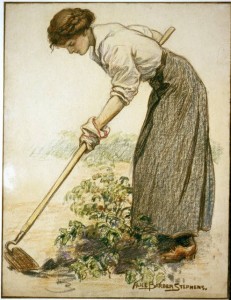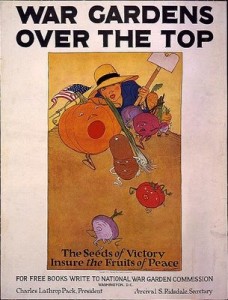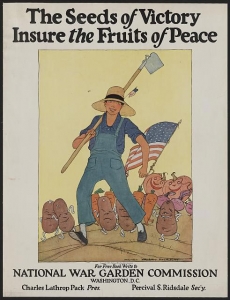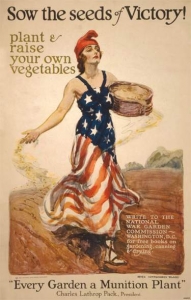
Alice Barber Stephens (1858-1932) | Somebody has to raise everything you eat, Do Your Share, c.1917-18 | Crayon on paper on board | Cabinet of American Illustration, Prints and Photographs Div. of the Library of Congress, CAI, Stephens, no. 16 (D size)
As the United States began to mobilize to participate in World War I in 1917 (also known as The Great War), President Wilson issued an executive order creating an agency, the Committee on Public Information (the CPI). Lead by George Creel, this agency sought the assistance of American illustrators to help create the images that would help convince the American public that United States participation in the war was not only necessary but indeed imperative. This was especially important because from the beginning of the war, Wilson and his government had promoted American neutrality.
Knowing that “. . . the poster must play a great part in the fight for public opinion . . . .” Creel enlisted the assistance of Charles Dana Gibson to marshal American illustrators into the Division of Pictorial Publicity (DPP). Among the many messages that the government needed to spread, was that Americans needed to increase the food supply at home in order to help the troops abroad by allowing food stuffs from land already cultivated to flow into the war effort while still keeping the home front fed by organizing the raising of more food in local garden plots.* Interestingly, the National War Garden Commission was organized weeks before the United States entered the war.
Among the posters created to support the War Garden Commission were some designed for the United States School Garden Army by Maginel Wright Enright Barney*, that urged children to also get involved in growing food for the home front. What makes her posters unique are the anthropomorphic vegetables either marching in step with the youthful farmer or running in terror from the child who wields the hoe (see below).
Maginel Wright Enright Barney (1881-1966); left, War Gardens Over the Top, c. 1919; right, War Gardens Victorious, c. 1919
Even the illustrator James Montgomery Flagg contributed to this effort creating a War Garden Commission poster. His depicts a lady Liberty, dressed in an American flag dress (designed by Flagg) with her head covered in a Phrygian cap, a soft conical fabric cap that signifies freedom and the pursuit of liberty—how appropriate. As she strides forward across the tilled earth, Liberty sows seeds for a new crop of food, and as the poster says, of victory.
James Montgomery Flagg (1877-1960); Sow the Seeds of Victory, c. 1918; National War Garden Commission
The illustration that marked the beginning of this essay, was one that was probably also submitted to the DPP and through them perhaps to the War Garden Commission, but it was not chosen to be used for the war effort.** The drawing is of a beautiful young woman shown working her hoe around the base of what could easily be interpreted as a healthy tomato plant. While the crayon drawing is beautifully rendered, it is essentially constructed as a very simple visual concept—the young woman dressed in everyday but nice looking clothing, bends her back to do the necessary work of doing her share toward producing food for consumption. Somebody has to raise everything you eat. Do Your Share!, the illustrator, Alice Barber Stephens reminds us via her title for drawing.
Stephens was an extensively trained artist and illustrator. Born in New Jersey, her Quaker family moved to Philadelphiawhen she was a girl. At the age of 15 she began her studies at the Philadelphia School of Design for Women, and then when she was 18 she studied at the Pennsylvania Academy of the Fine Arts with Thomas Eakins. When she was 28 Alice Barber married one of the instructors at the Pennsylvania Academy, then she subsequently studied with Howard Pyle at Drexel Institute with further studies in Paris at the Académie Julian and then at the Académie Colarossi. While we might be familiar with her illustration work, most of it dates from the late 19th or early 20th century, such as her illustrations for Ivory Soap advertisements from 1898.
As to why Alice Barber Stephens’ offering was not used, we can only speculate. Perhaps it was just too mundane. Compared to the Maginel Wright Enright Barney’s and Flagg’s posters, Stephens Somebody has to raise everything you eat. Do Your Share! is just too simple. There is no gimmick, no visual punch. There is nothing in Stephens’ perfectly lovely drawing to capture your attention amidst the myriad of poster offerings being produced in 1917 and 1918 to support the war. If the purpose of the posters of the DPP was to convince the American public to do what the government was exhorting them to do, then Stephens’ beautiful girl beautifully rendered would not have served the function set by the government.
* In the October 7, 2010 Exploring Illustration posting, “S.O.S. Means Save on Sugar” – The Campaign Against Sugar in the United States, grad student Daniel S. Palmer wrote about poster made for the United States Food Administration to promote food rationing.
** Maginel Wright Enright Barney, born Margaret Ellen Wright (1881-1966) was Frank Lloyd Wright’s younger sister. A successful illustrator, Maginel illustrated over 60 books. For more on her illustration see, the Exploring Illustration entry for November 26, 2009.
*** According to the Library of Congress record on this illustration, there is a note on the verso of the original board that says, “1917 0r 18, for poster” The title for this work was on its mat.
November 29, 2012
By Joyce K. Schiller, Curator, Rockwell Center for American Visual Studies, Norman Rockwell Museum









